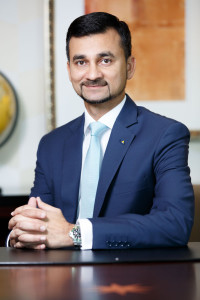 Saad Maniar, Managing Partner of Crowe Horwath UAE, explains how modern technology and software can be utilised to maximise finance business performance.
Saad Maniar, Managing Partner of Crowe Horwath UAE, explains how modern technology and software can be utilised to maximise finance business performance.
Recently, I was invited to join a high profile round table event organised by CNME’s parent company CPI, where finance leaders, CFOs and treasurers from leading organisations tackled the topic of how modern technology solutions are transforming the treasury function, giving rise to a new working platform and a fresh set of challenges and responsibilities for treasurers and finance professionals.
Key points covered in the roundtable discussions included a review of systems that provide full transparency and real time transactional frameworks for treasury functions, the strategic and logistical advantages that the new technology brings for areas such as predictive accounting, cash flow management and financial exchange governance and the evolving role of treasury management and how the new technology capabilities enhance the raft of banking relationships.
So, from Wall Street to back street, what’s driving this treasury technological transformation?
Here’s a simple answer. Before the financial crisis, many treasurers lacked real time visibility over their cash and risk positions and were using the traditional approach to finance reporting. However, since 2008-2010 credit risk and liquidity management have been at the forefront of corporate overhaul strategy, leading to a transformation in both the profile of treasury and the role it fulfills, and in the technology that facilitate visibility and control over cash and risk.
Needless to say that despite the dynamic changes in financial technology, the treasury function stubbornly continues to use some archaic systems and in some cases, paper-based solutions in the way they prepare their financial statements and reports and this continues to pose great challenge.
Granted, treasury has remained traditional for good reasons as well. It doesn’t want to join the bandwagon of disruptive technologies. Look at how technology like smartphones, mobile wallets, voice print, cloud computing and the like… are changing every single day with more functionalities. Treasury may look archaic, but remaining traditional has its positive side, as it guarantees security of data and minimizes chances of errors.
Implementing a secure treasury solution does not have to be as fast as these disruptive technologies. It should take an incremental and layered approach.
While modern technology and software makes treasury function easier in the area of preparation of financial statements, it also comes in handy when dealing with fraud. At Crowe Horwath, some of my mandates include overseeing the governance, risk and compliance practice. This involves developing, implementing and providing practical internal control systems and anti-money laundering solutions to minimize fraud.
As you are aware, cash and liquidity are the key treasury operations that include global cash management, forecasting, payment controls, bank relationship management and the funding structure of the business. Risk management is a core treasury activity to manage financial risks such as foreign exchange, interest rate, commodity prices and counterparty risk.
So, has this automation transformation addressed the needs of accountants and treasurers?
Partly. There’s no doubt technology has improved the way accounting and treasury functions, however it has not cured all ills.
The world is increasingly global in the level of connectivity and every day the pace of information moves faster than the one before. Organizations operate on a progressively global basis. As a result it becomes increasingly challenging to manage a central view of all financial arrangements.
As finance professionals, we are constantly bombarded with new tech compliance procedures.
However, even with the increased investment in treasury technology to comply with the procedures, the primary challenges facing treasury still exist. These include inadequate systems, financial exchange management, and visibility to global operations continue to be difficult.
Other challenges include a lack of clear understanding in terms of new compliance standards, lack of comprehensive controls across the organisation and the general compliance fatigue. Some organisations resort to outsourcing of some of the processes, which often leads to third parties having access to data they shouldn’t have access to.
We have seen organisations getting hacked because they thought they were compliant but they were not adequately amenable. Treasury departments are now being targeted in elaborate hacking attacks. With the growing complexity of the technology infrastructure, data storage surface, and multiple access points for cyber threat, many treasury management systems are still supported with the use of traditional homegrown approaches, which may pose greater cyber and operational risks.
Markedly, the range of risks that the treasury function is now expected to cover has expanded. As well as traditional risks such as foreign exchange volatility, liquidity and counterparty risk, the treasury function frequently manages complex, high-value transactions under tight time constraints, which can create the potential for operational errors leading to significant financial loss.
As finance professionals, measuring and monitoring treasury security must be an ongoing process. It is a dynamic security policy because the threat landscape changes every day. As effective as we are, criminals are equally savvy. It has to be dynamic.
Keeping up with modern technology will definitely help the treasury professionals perform their job more securely, efficiently, more cost effectively and in a timely manner.











